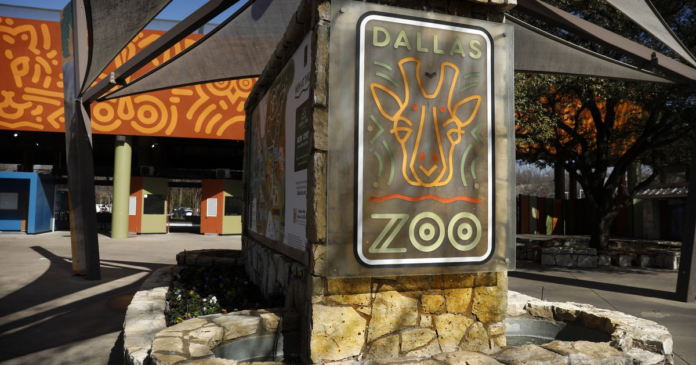Education programs for children. Global conservation projects. Exhibits made to mimic the wildlands with different species interacting with each other.
These are just some of the changes that zoos worldwide have implemented in the last few decades. Their role has evolved from a mainstay attraction to an educator and a protector of vulnerable and endangered species.
The Dallas Zoo is dedicated to 12 conservation priorities in Asia, Africa and in the U.S., which target efforts to save endangered animals, such as the okapi, Saharan Hoofstock and tiger.
As zoos’ roles have changed, so has another element: their ownership.
Such expectations are why cities have shifted to a nonprofit model, rather than operating zoos as part of their infrastructure, said Ryan O’Connor, assistant director of Dallas Park and Recreation.
In fact, 54% of zoos and aquariums in the United States and 12 other countries accredited by the Association of Zoos and Aquariums are run by a nonprofit.
“Zoos in the past were judged by who had the most animals,” said San Antonio Zoo CEO and President Tim Morrow. “Now zoos are really judged by who has the most natural, most enriching habitat for the animals, how much conservation work you’re doing, how much education.”
The Dallas Zoo is no exception.
The city of Dallas handed over control of its zoo to a nonprofit in 2009 as the city was dealing with a $190 million budget shortfall. City officials believed they would save money in doing so.
The private nonprofit, the Dallas Zoological Society, was also familiar with many zoo operations. It funded several exhibits, and its staff ran zoo marketing and concessions among other things.
The agreement went into effect in October of that year, and it has remained since.
The zoo is run by a subsidiary of the society, a management corporation called Dallas Zoo Management Inc. As part of the agreement, the zoo management is in charge of funding and operations, but the city owns the land and zoo facilities. The zoo, however, owns the animals.
The zoo still receives a taxpayer subsidy, which was capped at about $15 million last year, according to Dallas Zoo CEO and President Gregg Hudson. The city’s parks and recreation department oversees the management corporation and approves any changes to the 106-acre zoo.
The nonprofit model brought early success to the Dallas Zoo. It didn’t have to cut jobs and its exhibit work continued, including the construction of the Giants of the Savanna — an exhibit where elephants mingle alongside giraffes, zebras and ostriches, among other animals.
An African elephant eats straw in its Giants of the Savanna habitat at the Dallas Zoo, February 9, 2023. (Tom Fox / Staff Photographer)
The opening of the exhibit was the first major test for the zoo’s new management as it hoped to attract visitors. Now it faces another as a string of mysterious incidents took place over the past month, including torn enclosures and stolen animals.
Strengthening security could cost management millions of dollars, security experts told The Dallas Morning News. Any plan may add pressure to the zoo, which has a history of net losses and an over-reliance on funding sources from the past, according to a review of its finances by The News.
Pre-pandemic, the zoo averaged about 1 million visitors a year, peaking at 1.2 million. Hudson said attendance has plateaued since then. The zoo is climbing back up to those levels, drawing about 960,000 visitors last year, spokesperson Kari Streiber said.
The Dallas Zoo has also doubled its revenues since 2009, Hudson said.
Other cities in Texas also have zoos run by nonprofits. Houston, Fort Worth and San Antonio’s zoo are all run by nonprofits, privatizing in 2002, 1991 and 1931, respectively.
In terms of their size, the Dallas Zoo surpasses them all at 106 acres, but it only houses about 2,000 animals. The Houston Zoo has 6,000, while Fort Worth has about 7,000.
They all operate under similar agreements with their city, like in Dallas.
The one exception is the subsidy in San Antonio. The city pays about $306,000 to the zoo through its hotel occupancy tax fund — which is restricted solely for marketing purposes, Morrow said.
At the time the zoo privatized, the city paid about $1 million annually but over time that whittled down, he said. The zoo can still request further funding from the city through a public vote on bond projects, said Homer Garcia, the director of San Antonio Parks & Recreation.
It’s this arrangement that allows zoos to adapt to their new roles. “It allows the subject matter experts to do what they do best,” Garcia said. “When you think about our core service deliveries in the parks department, it’s not running zoos.”
And like in Dallas, other Texas zoos have embraced that role.
The San Antonio Zoo has its own nature-based preschool, Morrow said. The Fort Worth Zoo has 30 conservation projects around the world, said zoo spokesperson Avery Elander.
Hudson said he is proud of the progress the Dallas Zoo has made since it privatized. The conversations have changed since then, when the city was looking to get the zoo off its hands.
Now Hudson said the discourse is, “This is a much better economic driver. It’s a better-quality experience. It’s a tourism driver.”
Staff writer Yamil Berard contributed to this report.



